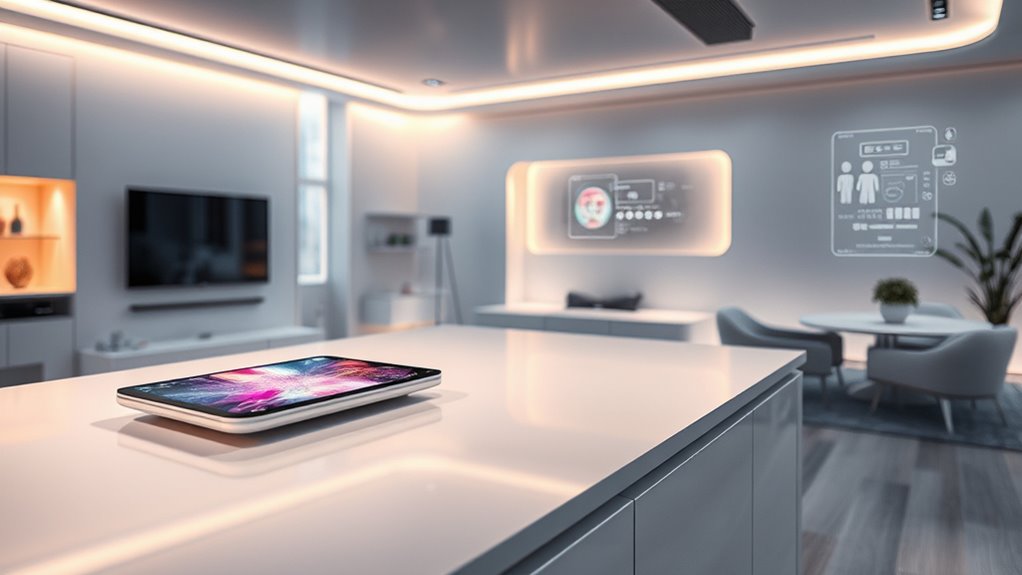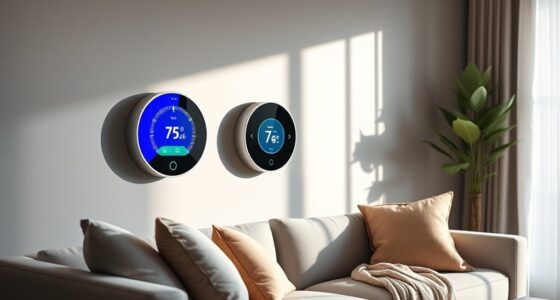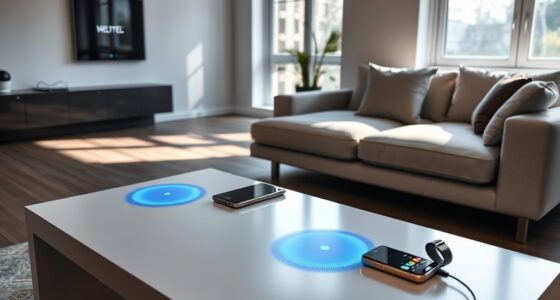Matter will change your smart home forever by creating a universal language that connects devices seamlessly, no matter the brand. It makes setup easier, improves security, and guarantees everything works together reliably. With Matter, you’ll enjoy simpler control through one app or voice command, while devices communicate more securely. This standard opens doors for more innovations and easier upgrades. Keep exploring to discover how Matter will transform your smart home experience even further.
Key Takeaways
- Matter enables seamless communication among smart home devices from different brands, simplifying setup and management.
- It enhances security and privacy with standardized encryption and authentication protocols.
- By unifying device control, Matter reduces the need for multiple apps and hubs, improving user experience.
- It accelerates device development and market adoption through streamlined testing and certification.
- Matter promotes interoperable, energy-efficient, and smarter homes with easier device integration and management.
What Is Matter and Why Was It Developed?

Ever wondered how smart devices across your home can seamlessly work together? That’s where Matter comes in. It’s a new standard designed to improve smart home interoperability, making devices from different brands work smoothly within one ecosystem. Before Matter, device ecosystem integration was often frustrating—apps didn’t sync, and devices couldn’t communicate easily. Developers created this standard to fix those issues, so your smart home becomes more reliable and user-friendly. Matter simplifies setup, reduces compatibility problems, and ensures devices can share data securely. By unifying how devices connect, Matter aims to make your smart home experience more effortless and consistent. It’s a major step toward a truly interconnected home, where all your smart gadgets work together effortlessly. Additionally, understanding smart home interoperability can help you better appreciate how standards like Matter improve device connectivity and user experience.
The Key Features and Goals of the Standard
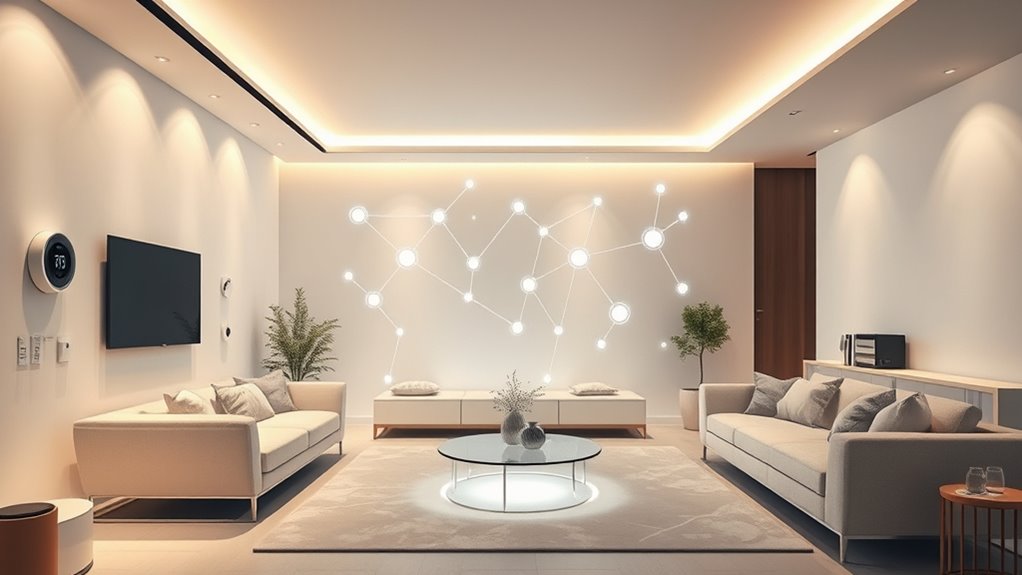
The key features and goals of the Matter standard focus on creating a more seamless and secure smart home experience. It aims to address interoperability challenges by enabling devices from different brands and ecosystems to work together effortlessly. This reduces frustration and simplifies setup, so you spend less time troubleshooting. A major goal is enhancing user privacy concerns, ensuring your data stays protected as devices communicate securely. Matter promotes robust security protocols, giving you confidence that your smart home remains safe from potential cyber threats. Additionally, the standard emphasizes ease of use, aiming to make adding and managing devices straightforward. For example, Pimple Patch technology demonstrates how targeted solutions can improve skin health, paralleling how smart home devices are designed for specific, effective functions. Overall, these features work together to create a unified, reliable, and privacy-conscious smart home environment that benefits you directly.
How Matter Ensures Compatibility Across Devices
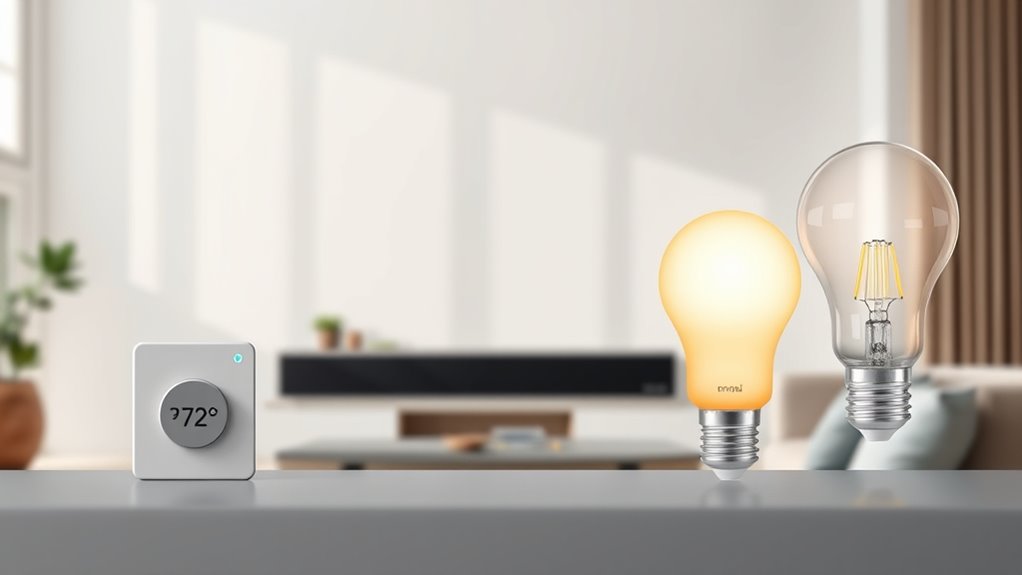
To guarantee your smart home devices work seamlessly together, Matter uses a unified communication protocol that all compatible gadgets can understand. This approach addresses interoperability challenges that often cause devices from different brands to struggle communicating. By standardizing how devices share information, Matter ensures you won’t face compatibility issues or need multiple apps for different products. This consistency considerably improves the user experience, making your smart home easier to manage. You can add new devices without worrying about whether they’ll work with existing ones, saving time and frustration. Overall, Matter’s focus on compatibility creates a smoother, more reliable smart home environment, where your devices work together effortlessly — no matter the manufacturer. Additionally, implementing Cultural Intelligence (CQ) strategies can help manufacturers better understand diverse user needs and preferences across global markets, enhancing product design and user satisfaction.
Simplifying the Smart Home Setup Process

With Matter streamlining the setup process, installing and configuring your smart home devices has become much simpler. You can now connect devices quickly using a single app or voice control, reducing frustration. Here’s how it helps:
- Easy onboarding: Devices automatically recognize each other, minimizing manual setup steps.
- Unified platform: Manage all devices from one interface, making it simple to customize routines for energy management.
- Seamless integration: Connect new devices effortlessly, ensuring they work together smoothly with existing systems.
- Incorporating automatic recognition technology further enhances the user experience by reducing setup time and errors.
This simplification encourages you to adopt more smart devices, enhancing your energy efficiency and convenience. With fewer barriers, setting up routines like adjusting thermostats or controlling lights via voice becomes faster and more intuitive, transforming your smart home experience.
Enhancing Security and Privacy in Connected Devices
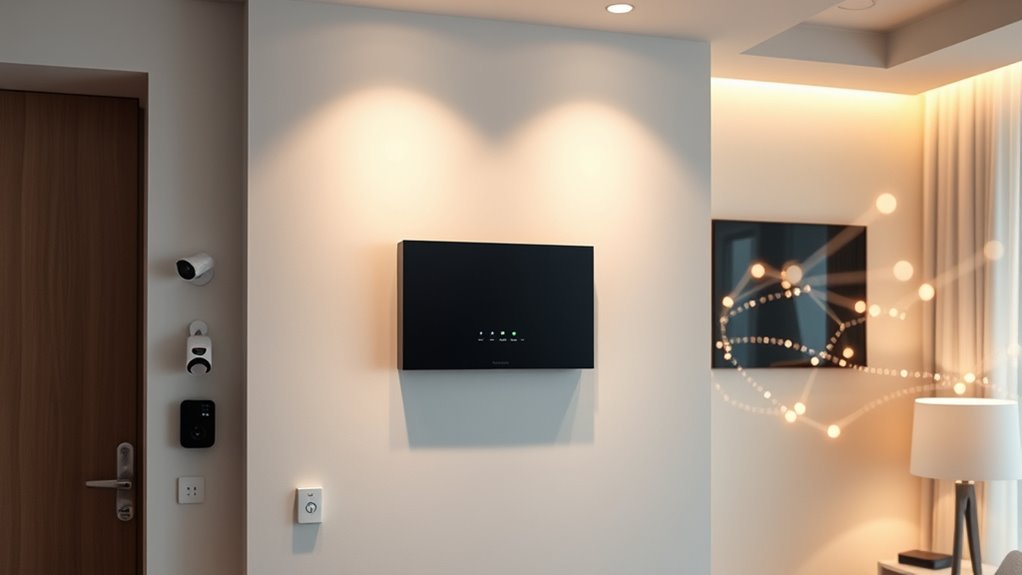
To safeguard your smart home, robust data encryption keeps your information safe from prying eyes. Standardized privacy protocols guarantee your devices handle your data consistently and securely. Together, these measures help you enjoy smarter living without compromising your privacy. Additionally, implementing AI safety measures can further protect connected devices from potential vulnerabilities.
Robust Data Encryption
As smart homes become more interconnected, robust data encryption has emerged as a crucial safeguard against cyber threats. It guarantees that your data stays private and protected from hackers. To achieve this, focus on three key elements:
- Securing device firmware updates to prevent malicious code from infiltrating your devices.
- Implementing strong user authentication methods to verify your identity before granting access.
- Encrypting data both at rest and in transit, making it unreadable to unauthorized parties.
- Incorporating principles of Self-Understanding can help users better recognize vulnerabilities and adopt more secure habits within their smart home systems.
Standardized Privacy Protocols
Standardized privacy protocols are essential for ensuring that your connected devices communicate securely and protect your personal information. These privacy standards set clear guidelines for data protection, helping prevent unauthorized access or data breaches. When devices follow common protocols, it’s easier to maintain consistent security measures across your smart home ecosystem. This reduces vulnerabilities and builds trust in the technology you rely on daily. Implementing these standards also simplifies updates and troubleshooting, ensuring your privacy remains intact over time. By adhering to universal privacy protocols, manufacturers can deliver better data protection, minimizing risks associated with interconnected devices. Additionally, incorporating Bedroom design principles can inspire more user-friendly and aesthetically pleasing smart home integrations. Overall, these protocols create a safer environment, giving you confidence that your personal data stays private and secure in the evolving world of smart homes.
The Impact of Matter on Manufacturers and Developers
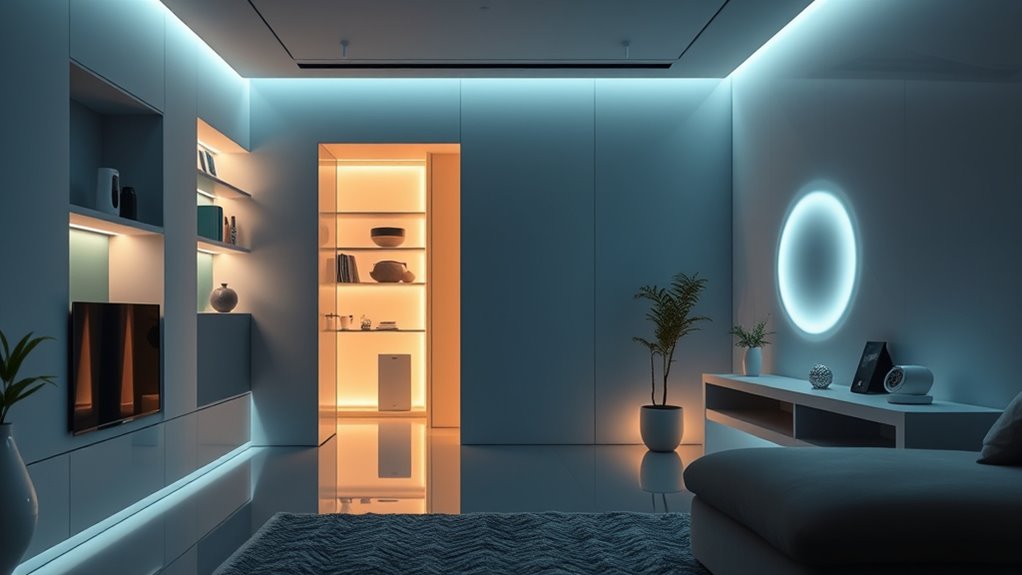
Matter makes it easier for you to integrate devices from different brands, reducing compatibility issues. It speeds up product development, so you can bring new smart home solutions to market faster. Plus, it opens up more market opportunities, helping you reach more consumers worldwide. Improved interoperability ensures seamless operation of various devices, enhancing overall user experience.
Simplifies Device Integration
By streamlining the process of device integration, Matter makes it easier for manufacturers and developers to create compatible smart home products. This reduces complexity, so you can enjoy seamless voice control across devices. It also encourages the development of features that boost energy efficiency, helping you save on bills and reduce environmental impact. With Matter’s unified standards, you no longer need multiple apps or hubs, simplifying setup and management. Additionally, creative problem-solving skills can help developers address integration challenges more effectively.
Accelerates Product Development
As a result of unified standards, manufacturers and developers can bring new smart home products to market more quickly than ever before. This reduces interoperability challenges, allowing devices from different brands to work seamlessly together. With fewer hurdles, you’ll see innovative products reach consumers faster, boosting consumer adoption. Developers spend less time troubleshooting compatibility issues and more time focusing on features that matter. Manufacturers benefit from streamlined development processes, cutting costs and accelerating timelines. Additionally, testing and certification become more efficient, ensuring higher quality products. As a result, you’ll have access to a broader range of reliable, compatible devices sooner. This rapid product cycle not only enhances your smart home experience but also encourages manufacturers to innovate continuously, knowing that Matter’s standards help ensure their products will integrate smoothly with existing ecosystems.
Expands Market Opportunities
With unified standards removing compatibility barriers, manufacturers and developers now have the opportunity to access broader markets and reach more consumers worldwide. This shift allows you to leverage wireless connectivity seamlessly across devices, expanding your product’s reach. You can also offer greater user customization, catering to individual preferences and smart home lifestyles.
- You’ll streamline product development, reducing costs and time-to-market.
- You can design devices that work effortlessly together, improving user experience.
- You’ll tap into new markets with confidence, knowing your products meet universal standards.
As a result, you’ll boost innovation, increase sales, and position your brand as a leader in the evolving smart home ecosystem.
Real-World Examples of Matter in Action

Have you ever wondered how Matter will transform everyday smart home devices? With Matter, you’ll notice seamless integration across products, making your user interface more intuitive. For example, controlling your smart thermostat or lighting becomes simpler, with devices working together smoothly through a unified platform. This reduces setup time and frustration, enhancing your experience. Additionally, Matter’s standardization promotes energy efficiency by optimizing device communication and operation. Your smart appliances can coordinate better, adjusting energy consumption based on real-time needs, which saves you money and reduces environmental impact. These real-world examples show how Matter’s adoption leads to smarter, more efficient homes that are easier to manage. As you interact with your devices, you’ll appreciate the streamlined functionality and energy-conscious features that Matter makes possible.
Challenges and Limitations Facing the Adoption of Matter

While Matter promises a more seamless smart home experience, several challenges could slow its widespread adoption. First, interoperability hurdles may arise as manufacturers implement the standard differently, causing compatibility issues. Second, cost barriers might prevent some consumers from upgrading existing devices or purchasing new Matter-compatible products, especially if prices are high. Third, the handover period could be complicated, with older devices needing updates or replacements to work with Matter. These obstacles could delay the full realization of Matter’s potential. Overcoming interoperability hurdles requires industry collaboration, while addressing cost barriers involves reducing manufacturing expenses and offering affordable options. Until these challenges are managed, the adoption of Matter might not reach its full promise of simplicity and universal compatibility.
The Future of Smart Home Technology With Matter

As Matter continues to gain traction, it is poised to revolutionize the smart home landscape by making devices more compatible and easier to use. With seamless integration, you’ll find voice control more responsive and reliable across different brands and devices. This standard simplifies setup, so you spend less time troubleshooting and more time enjoying your smart home. Additionally, Matter’s focus on energy efficiency means your devices will operate smarter, conserving power without sacrificing performance. You’ll be able to automate lighting, heating, and appliances more effectively, reducing energy waste and lowering bills. Overall, the future of smart home technology with Matter promises a more intuitive, efficient, and interconnected experience that adapts to your lifestyle with minimal effort.
Frequently Asked Questions
How Does Matter Impact Existing Smart Home Ecosystems?
You might wonder how Matter impacts your existing smart home ecosystem. It addresses interoperability challenges by enabling devices from different brands to communicate seamlessly, which improves your user experience. With Matter, you won’t have to juggle multiple apps or worry about compatibility issues. Instead, your smart devices become more integrated, making your home smarter and more user-friendly, simplifying setup, control, and automation across your entire system.
Will Matter Increase or Decrease Device Prices?
Imagine a world where smart home gadgets become as cheap as your favorite snack—thanks to Matter. You’ll see device prices decrease as cost reduction strategies kick in, making smart tech more accessible. Plus, the innovation boost means manufacturers will compete to offer better, affordable products. So, instead of draining your wallet, Matter will make your smart home smarter and cheaper, turning tech dreams into everyday realities.
Are There Any Known Compatibility Issues With Older Devices?
You might wonder if older devices face compatibility issues with Matter. Generally, legacy integration can be challenging, but firmware updates are helping bridge the gap. Manufacturers are releasing updates to make older devices compatible, yet some may still struggle due to hardware limitations. It’s wise to check if your devices have received recent firmware updates and support Matter to guarantee seamless integration with your smart home ecosystem.
How Will Matter Influence Third-Party Accessory Development?
You might think third-party accessories will face hurdles with Matter, but in reality, it offers significant developer opportunities. By addressing standardization challenges, manufacturers can create universally compatible devices, boosting innovation and consumer choice. This seamless interoperability encourages developers to design new, smarter accessories without worrying about compatibility issues. As a result, Matter will empower third-party accessory development, making your smart home more versatile, reliable, and easier to upgrade.
What Are the Long-Term Privacy Implications of Matter?
You should consider the long-term privacy implications of Matter, especially around data privacy and user control. As this standard connects more devices, your personal data could be at greater risk if not properly safeguarded. However, with strong security measures and clear user control options, you can maintain your privacy. Stay informed about updates and settings to ensure your data remains safe as Matter evolves and becomes more widespread.
Conclusion
With Matter weaving a seamless fabric through your smart home, you’ll find devices harmonizing like a well-orchestrated symphony. It’s the key that *releases* ease, security, and endless possibilities, turning chaos into clarity. As this standard grows, your connected world becomes a smooth river flowing effortlessly. Embrace the wave of innovation, where technology dances in perfect harmony—making your smart home not just smarter, but a sanctuary of simplicity and security.
